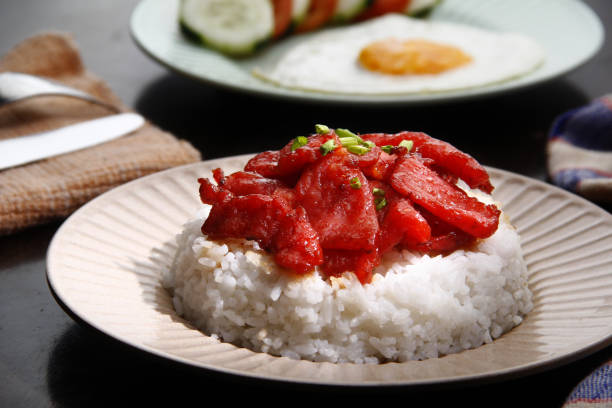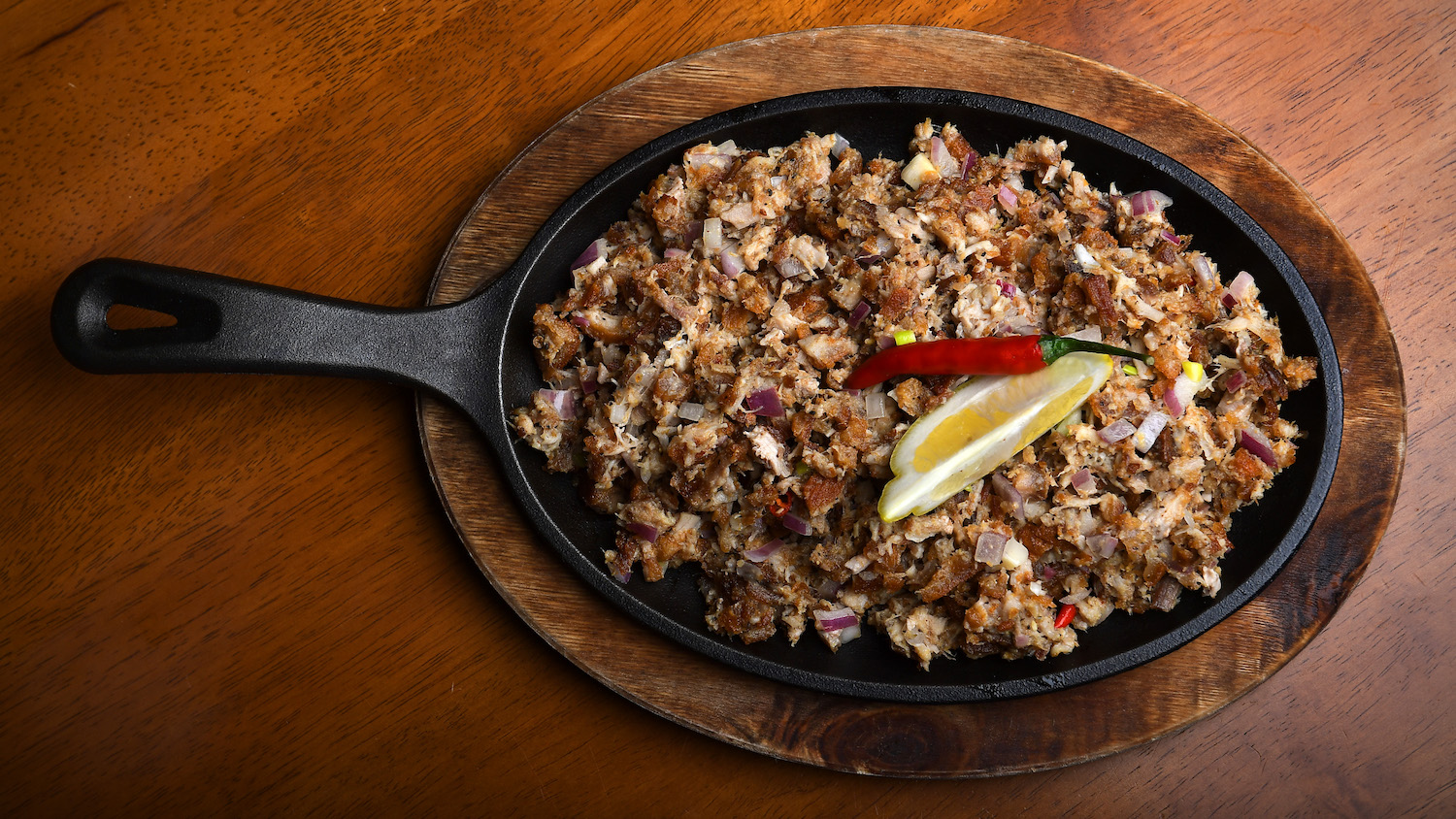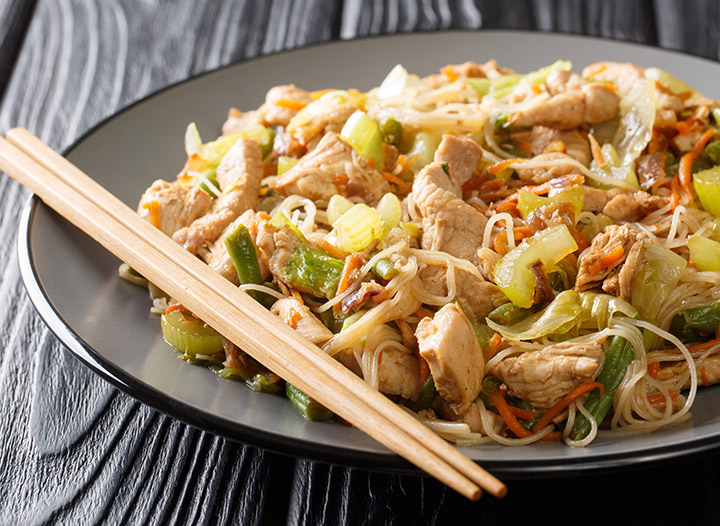Tocino, also known as burong babi, is a traditional Filipino dish of sweet cured pork meat. It’s often made with pork belly or pork shoulder. And it’s so popular that in the Philippines, you can buy tocino–flavored Spam for a slightly sweet take on the canned food.
It is best known as a breakfast dish — served with garlic rice or white rice, and an egg. But you’ll also find it as a bar snack since it’s texture is similar to jerky.
Read on to learn more about Filipino tocino and how it’s typically served.
What is tocino?
This dish has many variations across the world (which we’ll explain further down below). In Spain, the word “tocino” means bacon, though it refers to the layer of fat under a pig’s skin. This Spanish version is often made from pork belly, then it’s salted and cubed. In the Caribbean, it’s diced, fried to a crisp, and then served with rice or mofongo.
Fillipino tocino is traditionally made with pork belly or pork shoulder meat. It’s sliced into one-inch thin strips, cured, and then sautéed.
Most often, you’ll see pork tocino being served as a Filipino breakfast. It will be paired with sinanag (“garlic fried rice”) and itlog (“fried egg”), under the name of tocilog, which describes the trifecta of all these foods. Tender, sweet cured pork with savory, garlicky rice that’s topped with a gooey egg is a tough combination to beat.
Although the dish is typically associated with breakfast, its similarity to jerky also makes it a fantastic bar snack. And it’s a beloved accompaniment to an ice cold San Miguel beer.
You’re likely to see it on a Filipino bar menu in the pulutan or finger food section. Pulatan (which is Tagalog for “pick up”) will see the meat served on a skewer, allowing you to easily pick it up, or eat while on the go.
The History of Tocino
Many of the world’s most interesting foods — meals which are now a daily staple in various cultures — began by accident or necessity. Often, desperation inspires innovation. Tocino’s story is said to have one of these innovative origins.
We even know the name of the woman who invented it: Lolita O. Hizon. Her neighbor was a meat vendor who had some leftover pork meat which he didn’t want to go to waste. He asked her to help save the meat, so she decided to ferment it using a traditional local method. Impressed by what she had made, Hizon refined the formula until it became a mainstream sweet-and-salty success in the Philippines.
Nowadays, tocino is so popular that it’s sold as the main food product by Pampanga’s Best. They boast theirs as the original recipe, and even feature Hizon’s face on the packaging. It’s readily available to buy in most Filipino grocery stores so you don’t have to make it yourself at home.
How is tocino made?
The process of making tocino typically involves marinating the meat in a mixture of soy sauce, salt, brown sugar (or white sugar), and vinegar. It’s then left overnight at room temperature to ferment. After one to three days, the cured meat then becomes more tender and takes on a red tone. Traditionally, Annatto seeds are added to deepen the red color and leave a peppery flavor. But many recipes now will call for red food coloring instead.
After the curing process, the meat is cooked in a wok over medium heat. This gives tocino its characteristic chewiness, drawing out the fat from within the meat, and allowing the brown sugar to give the meat its shiny caramelized coating.
Over the years, the recipe has become more simplified. Pampanga’s Best has their packaged version of tocino and there are other brands as well. For most of them, you would just cook the tocino in a pan with about a half-cup of water until most of the liquid evaporates. Many years ago, tocino meat had to be left outside to air dry for a day before being rubbed with ange tree bark for color.
These days, you’ll also find chefs in the U.S. adding inspired twists in the tocino marinade for subtly different flavors like garlic, pineapple juice, kiwi juice, or even soda.
Other Variations of Tocino
As the Spanish left their culinary footprint across the world through generations of colonialism, you can also find other variations of tocino in areas such as Latin America and the Caribbean. Here are a few options to keep an eye out for:
Latin American and The Carribean: You’ll find the tocino here is made from pork fatback and cut into very small pieces before being fried until crunchy and used as part of other dishes. Examples include fried rice with mofongo which is a dish originally from Puerto Rico that uses plantain and is served with soup.
Spain and Venezuela: Spanish (and Venezualean) tocino refers to the fat under the pig’s skin. This fat is salted and cut into cubes before being added to a variety of traditional dishes.
While tocino is traditionally made with pork, it is possible to find variations that are made with chicken or beef making it more accessible for those who don’t eat pig. When making it with chicken, the thigh is traditionally used as it is juicer. These are sliced into bite-sized chunks before curing as usual. For a beef option, a tenderloin will be sliced thinly and cooked as per the traditional recipe.
Where to Eat Tocino in the U.S.
It’s easy to find this dish at most Filipino restaurants, especially on the breakfast menu. But there are a number of eateries especially known for their tocino or Filipino breakfast foods. Here’s a list:
Southern California:
Big Boi in West Los Angeles is known for Filipino comfort food and offers classic dishes like adobo, sisig, sinigang, and tocino.
Eagle Rock Kitchen and Silog are other popular Filipino comfort food eateries that serve tocino.
Spoon & Pork is known for the pork dish as well, and they even offer it in banh mi form.
Northern California:
FOB Kitchen in Oakland makes their house cured tocino with pork shoulder meat.
Gateway Kitchen in Daly City even serves theirs with diced pineapple.
You can get the dish for under $5 at Superstar Restaurant, an order-at-the-counter style cafe, just south of San Francisco.
Malasa in SF’s Inner Sunset neighborhood features upscale Filipino dining, with a notably tender tocino.
Pacific Northwest:
In Seattle, Knee High Stocking serves tocino bowls, Big Boys Kainan serves burritos, and Manila Sunset serves the meat with egg.
In Portland, Tamago Bros serves pork and chicken variations, while Fork and Spook Food House serves up their tocino with a little char.
New York:
Grill 21 serves theirs with a small side of soy sauce with vinegar.
Tsismis serves pineapple tocino liempo, which boasts braised then charred pork belly served with a fried egg, garlic fried rice, and chayote (or squash) relish.
The next time you find yourself at a Filipino restaurant, make it a brunch treat for yourself and consider ordering the tocilog. Just be sure to ask for some extra garlic fried rice.



